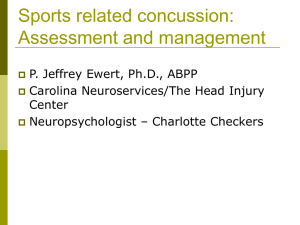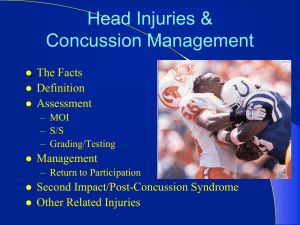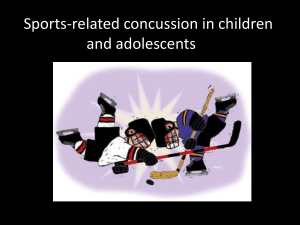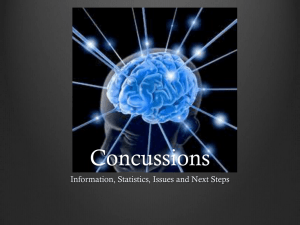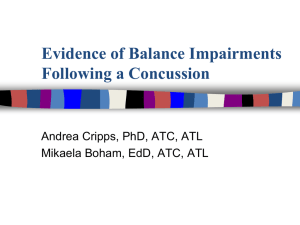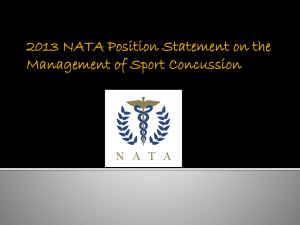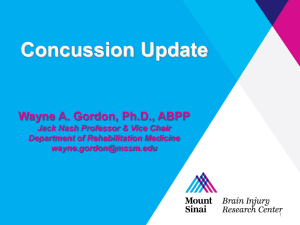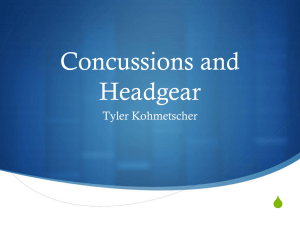Concussions in Sports
advertisement
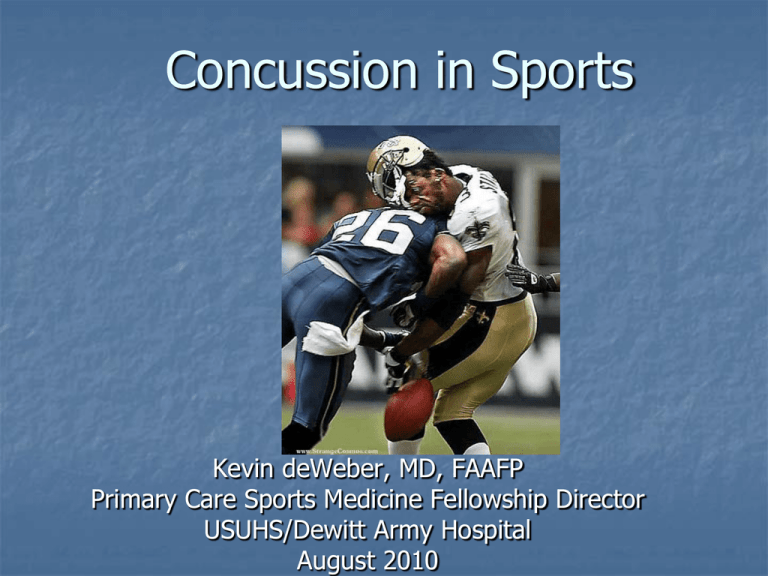
Concussion in Sports Kevin deWeber, MD, FAAFP Primary Care Sports Medicine Fellowship Director USUHS/Dewitt Army Hospital August 2010 Zurich Guidelines Consensus Statement on Concussion in Sport. 3rd International Conference on Concussion in Sport Held in Zurich, November 2008. Clin J Sports Med May 2009; 19(3):185. Concussion - Definition Complex pathophysiological process affecting the brain Induced by traumatic forces Direct or Indirect Functional Disturbance rather than Structural Injury No abnormality on standard structural neuroimaging Pathophysiology Neuronal dysfunction Ionic shifts Altered metabolism Impaired connectivity Changes in neurotransmission Neuropathological Changes No evident structural changes Classification Simple vs Complex Signs and Symptoms One or more of the following: Symptoms Physical Signs Irritable, nervous Cognitive Impairment Loss of Consciousness, Amnesia, motor/sensory deficits Behavioral Changes Somatic: Headache, pressure, neck pain, n/v, vision changes, balance problems, light or noise sensitivity, “don’t feel right” Cognitive: Feeling “In a Fog”, difficulty concentrating or remembering, confusion Emotional: more emotional, sadness, Slowed reaction times, memory or concentration deficits Sleep Disturbance Drowsiness, difficulty falling asleep What proportion of athletes recognize symptoms as being due to a concussion? 1. 2. 3. 4. 5. 1 of 10 1 of 5 1 of 3 1 of 2 Practically all 1 of 3 Implication: YOU as the physician need to be LOOKING for athletes w/ concussion On the Field Management If unconscious, assume cervical spine injury Stabilize c-spine Don’t rush to get the athlete off the field, but also don’t do your entire neuro/mental status exam on the field either Sideline Management Place the athlete in a area where he/she can sit, not be bothered by other athletes and coaches, and can hear questions Sideline Management Notify coach that the athlete is out until further notice Consider giving the athlete a few minutes to regain his composure Observe the athlete blank stare, shaking head, abnormal body language Assess with brief concussion tool Maddocks questions SAC Pocket SCAT2 Brief neuro exam Symptom score Glascow Coma scale Maddocks game questions Short Assmt of Concussion (SAC) Balance Coordination Concussion or not? YES – if ANY of the following: Symptoms OR Signs (LOC, neuro deficits, cognitive deficits) Pearl Once a concussion has been diagnosed, take and hide the athlete’s helmet/headgear to prevent him from returning to the game 1. 2. 3. 4. 5. Q: For a concussion with no loss of consciousness and resolution of symptoms in less than an hour, when is return to play safe? Immediately Second game of double-header In 24 hours In 10 days Determined on case-by-case basis Return to Play Rules Individualized RTP decisions no cookie-cutter RTP guides NO ONE returns while still symptomatic Athletes must be asymptomatic both at rest, w/ cognition, and w/ exertion Must have normal cognitive function “There is data...that, at the collegiate and HS level, athletes allowed to RTP on the same day may demonstrate NP deficits post-injury that may not be evident on the sidelines and are more likely to have delayed onset of symptoms.” …Zurich guidelines 2009 Symptoms may be delayed or recurrent Many athletes may seemingly “normalize” within minutes of an injury, but then have a recurrence and potential worsening minutes to hours later IMPLICATION: very rare same-day RTP Explain Risks of Premature RTP before full recovery 2nd impact syndrome Death Higher risk in young athletes 2nd concussion, more severe Prolonged symptoms Staged Return To Play: 24 hours for each stage 1. 2. 3. 4. 5. 6. Cognitive and Physical Rest until asymptomatic Light aerobic exercise Sport-specific aerobic exercise Noncontact drills; light resistance training Full-contact training if medically cleared Game play Staged Return to Play 24 hours for each stage Progress to next stage ONLY if asymptomatic If sxs recur w/ exertion: Return to the previous stage Rest for an additional 1-3 days Return to stage 1 OR OR f/u Management Issues Comprehensive evaluation Imaging? Serial assessments until normalized Neuropsych testing Symptom treatment Activity progression Return to play determination In-Office (or ED) Comprehensive Evaluation Comprehensive H&P and detailed neuro exam by HCP Clinical status determination Mental status Cognitive function Gait and balance Improvement vs deterioration Determine if emergent neuroimaging is needed Immediate Imaging? Consider an immediate CT scan under the following conditions: Prolonged loss of consciousness (>60 seconds) Post-concussive prolonged seizures Major neurological deficits, especially motor deficits Significant lethargy or rapid/progressive worsening of symptoms Computed tomography and MRI rarely have a role in the diagnosis of uncomplicated concussions “Concussion Modifiers” Things that may influence eval, mgmt, and may predict prolonged recovery Severe symptoms, or duration >10d LOC > 1 minute, or amnesia Concussive convulsions (other than immediate) Repeated concussions, esp close together or progressively requiring less force < 18 years age Co-morbidities: migraine, depression, ADHD, LD, sleep disorders Psychoactive drugs, anticoagulants Dangerous style of play Contact/collision sport, high sporting level ?? Female gender Implications for + “Modifiers” Neuropsych testing more important Balance assessment more important Neuroimaging more important Multi-disciplinary management Post-Game Management Find out the plans of the athlete for the evening Who can monitor him? Suggest strict rest Supply the athlete and/or roommate/parents with phone numbers for the physician or ATC Give copy of SCAT2 insgtructions Schedule follow-up with ATC or MD Next day for moderate-severe concussions 1-3 days for mild concussions Monitor for cognitive recovery with Neuropsych Testing One of the cornerstones of concussion evaluation Tools available Sport Concussion Assessment Tool (SCAT2) Poor-man’s method Computerized testing--$$ but GOOD ImPACT (Immediate Postconcussion Assessment and Cognitive Testing) Headminder CogSport ANAM (Automated Neuropsych Assmt Metrics) Neuropsychological Testing OBJECTIVE evaluation of function Baseline testing is VERY helpful Allows comparison of baseline to post-injury tests If baseline testing not available, compare to age-matched controls and a percentile generated Neuropsychological Testing When to test and how often? most useful when athlete becomes asymptomatic may be useful for the symptomatic STUDENT athlete to help plan school & home mgmt Neuropsychological tests should neither be the primary determinant regarding return-toplay, nor should they take the place of good clinical judgment Concussion Treatment Symptom Treatment REST!... the only known effective treatment for a concussion Encourage frequent breaks from studying Encourage good hydration and regular meals to avoid dehydration and hypoglycemic-related headaches Medications Tylenol may be used to treat headache symptoms if there is no immediate intent to return-to-play NSAIDs safety? No sedating meds Managing Exercise 1. Rest completely until asymptomatic and NP test suggests resolution 2. light aerobic exercise Preferably indoors, e.g. stationary bike 3. sport-specific exercise E.g. running, skating, swimming Managing Exercise (continued) 4. non-contact sport drills 5. Full-contact practice (if medically cleared) 6. Competition Managing Exercise: Principles To advance to the next stage, the athlete has to remain asymptomatic If symptoms develop, then consider: Rest for an additional 1-3 days Return to the previous stage Return to stage 1 OR OR Consider making each stage 2-3 days if returning from a more severe concussion or if multiple concussions during that season Special Populations Q: Compared to adults, children’s and adolescents’ recovery from concussion can be described as… 1. 2. 3. Slower recovery Slower recovery Same rate of recovery Faster recovery High school athletes’ recovery from concussion 90 80 70 60 50 % returned 40 30 20 10 0 1 week 2 weeks 3 weeks Collins M, et al. Neurosurg 2006 Pediatric Athletes (<18) AAP recommends “conservative” management NO return to play on same day Seriously, NO return to play on same day Student Athlete Management COGNITIVE REST If sxs recur with cognitive activity, time off school may be needed Involve teacher, school nurse, principal, coact Student Athlete Management Trial and error; no students alike Tailor activities to minimize sxs Drive to school Reduce length of school day Rest periods as needed Reduce homework Longer time for tests; delayed tests Minimize background noise & excessive light Elite vs. Non-Elite Athletes Manage using SAME tx and RTP paradigm Recommend formal baseline NP screening in high-risk sports In-Game Return-to-Play is CONTROVERSIAL Only clear an ADULT, PROFESSIONAL athlete for return to same game under the following conditions: Initial presentation was mild (no LOC) Symptoms completely resolve within only a few minutes (less than 5-10) All neurological testing is normal Sport-specific drills (running, cutting, kicking, catching) reveal normal speed and coordination and do not cause any symptoms You truly believe the athlete is being honest with regards to the reporting of his symptoms Return to Play Decisions: The tough cases Three or more concussions: end the season At least 3 months before resuming any contact sports Decreasing levels of trauma producing concussion End the career Robert Cantu, expert opinion, Curr Sports Med Rep 2009 Persistent Cases (>2-3 weeks) Multidisciplinary approach needed Physician Control HA’s with meds Referrals Full neuropsych testing Refer for specific treatment of identified problems The Role of Imaging PET scans, SPECT scans and functional MRI may be on the horizon to assist with concussion diagnosis, severity grading and return-to-play NCAA Concussion Management Memo to Head ATCs April 2010 Must have concussion mgmt plan on file Athletes w/ suspected concussion WILL BE removed from practice/competition and be evaluated Unchallengeable mgmt authority by healthcare providers Baseline assessments required No RTP that day MIN: Symptoms, cognitive fxn, balance fxn Final RTP authority: Tm Physician/ designee Conclusion Individualize your approach with each athlete Concussion management is not “cookie-cutter” medicine Disqualifying an athlete from competing for the remainder of the season is difficult, and must be individualized and based on multiple factors Determine who your concussion experts are Who manages the most? Many neurologists and neurosurgeons rarely see or manage athletes with concussions Questions?


